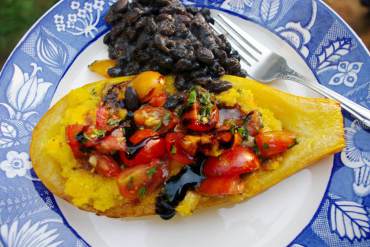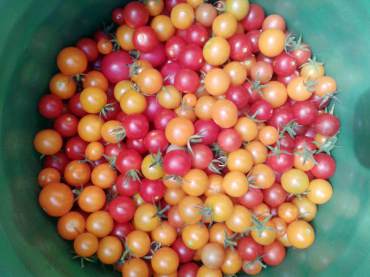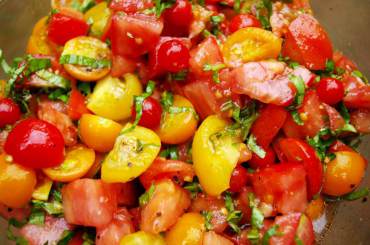
If you have a vegetable garden, you probably want all your produce to be used well. But there is a limit to how much produce one household can consume.
Puget Sound gardeners get an average of 10 pounds of tomatoes from each plant (and as many as 25 pounds), according to The Brothers Greenhouses tomato trials. These kinds of harvests call for more than a few snacks in the garden. During busy summer harvest, it’s nice to have recipes at the ready and plans for garden gifts.
Garden Abundance
Most summer crops are versatile for various cuisines. This is good news for those who tire of the same harvest dinners.
If you grow tomatoes, consider that they’re the base of many dishes — from Indian curry to Southern jambalaya.
Do you have garlic and basil? Dice with tomatoes into Italian bruschetta and eat it on crostini. Go beyond salsa and try making gazpacho, a Spanish cold soup.

Is your garden full of eggplant, zucchini, tomatoes, onions and garlic? Stew like the French do, as Ratatouille. Have lots of zucchini and tired of the norm? Try roasting it with garlic, onions, peppers, eggplant and herbs, and purée them for “zuccamole.” Stuff and bake zucchini with polenta and top it with bruschetta.
Squash blossoms (especially the male flowers) can be stuffed with chevre and sautéed or baked for a delicate appetizer. The possibilities are endless! Trying new things keeps it interesting for you and the people you’re serving.
Upgrading Classic Dishes
Kitchen classics lend themselves to upgrades with excess harvests. Pestos are deliciously versatile beyond basil — cilantro, oregano, rosemary or tarragon. Add extra veggies into your favorite dips, sauces, frittatas or quiches. Make colorful homemade pasta with puréed beets, spinach or carrots. Stuff ravioli with sautéed greens, then smother them with marinara or cheese sauce.
Fritters (pancakes from vegetables) can be made with any vegetable that can be shredded. As for baked goods, carrot cake, zucchini bread and zucchini cake are welcome additions to potlucks.
As fruits ripen, organize multigenerational preserving parties to pass down recipes and techniques. Any fruit can be made into ice cream, gelato or sorbet — which can be done with a mixer attachment or any freezer container.

Garden Giving
Sharing harvests can be a great way to strengthen your food community and share ideas about eating locally. Be strategic. Share vegetables with those who raise meat, catch seafood or forage from the forest.
Your shared garden bounty will keep them thinking about you when it comes time for their harvest, and they might just fill your freezer. Sharing helps everyone involved eat a more balanced diet of fresh, local, healthy food. It’s also fun to share ideas and inspiration.
Quality, Presentation and Usable Quantity
A few tips with garden-giving etiquette are important to keep neighbors excited to see you approaching with a harvest basket.
Presentation is important. Think about what would sell at a market. It’s important that gifts are of high quality, clean and in usable quantities.
It’s said that one ought not to leave windows down in parking lots during harvest season, or else might be tricked by a “zucchini houdini” with an appearing act of colossal harvests. Hot summer days make it challenging to keep the zucchini harvests in check, but smaller is better. Small zucchini is much easier to use and picking this way keeps the plants producing.
Tomatoes are easier to give away. Knowing favorite foods of your friends and family helps strengthen community rapport. If your produce has gone beyond marketable quality, think about someone you know with chickens, and at least your harvest will become eggs!
If you’re getting so many vegetables that you can’t keep up, you might consider setting up a roadside stand or selling at a local farmers market. Doug’s Harlow Gardens, near Kitsap Lake, is a good example of how approachable this can be.
Growing and Eating Closer to Home
Food grown in small gardens is more space-efficient, purer and of better quality than that grown in mass quantity. Sixty percent of vegetables in Russia are grown in home gardens, according to a recent article in Acres magazine, and 80 percent of potatoes, fruits and berries there are homegrown.
Even during the victory gardening era of the world wars, Americans grew 40 percent of produce in small gardens, according to History.com. Modern Northwesterners seem increasingly interested in eating locally. Finding other people to swap with can start with hosting harvest potlucks or meals made from contributions from different gardens, like Kitsap Community & Agricultural Alliance‘s Annual Harvest Dinner.
A recipe swap shares information about living well in this region. And live well, we do.
What percentage of produce will your family eat from small gardens in coming years?





























Comments